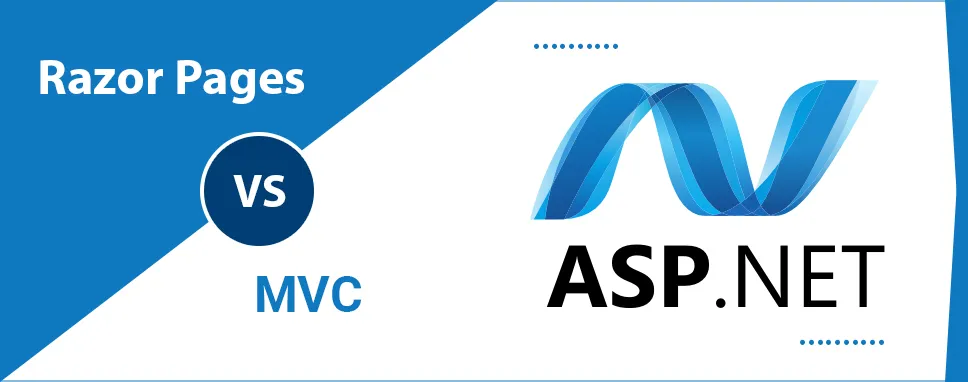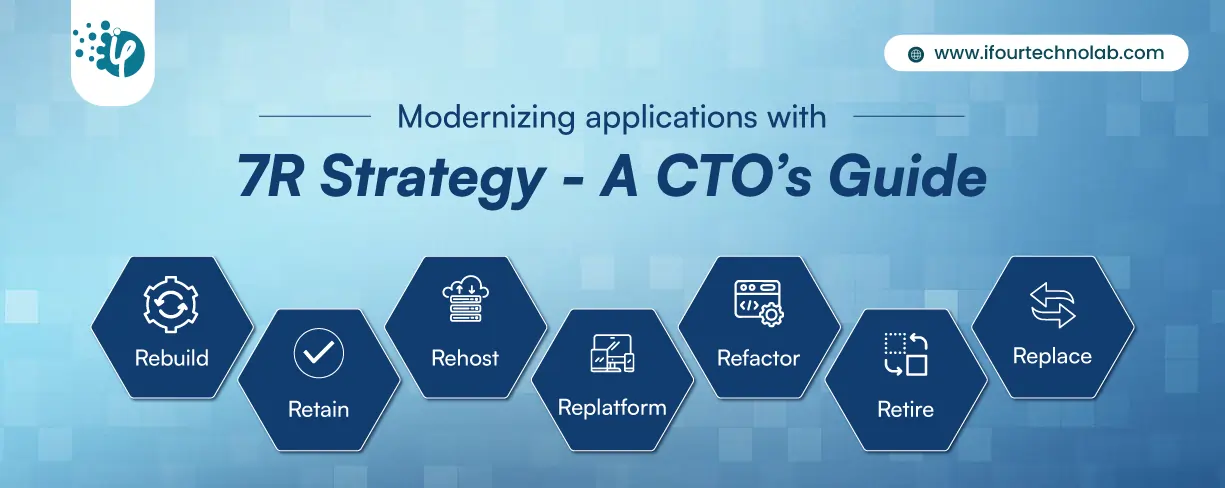Modernizing applications with the 7 R strategy – A CTO’s Guide
Think about the last time CTOs spent most of their time fixing old systems. Updates were slow, servers were expensive, and adding new features took time. Now, things have changed....
Listening is fun too.
Straighten your back and cherish with coffee - PLAY !

ASP.NET is a remarkable framework made by Microsoft for .NET application development services . It has some awesome features that make software development easier and faster. In this blog, we're gonna talk about Razor vs MVC, two different ways to use ASP.NET, and how they can help you out. So, let's get started!
ASP.NET is a type of software framework/infrastructure that was developed by Microsoft. ASP.NET is used for developing, running, and deploying the applications same as console applications, window services, and web applications. It is a web application of .NET framework that is used to create dynamic web pages.
It does not require any license for developing web applications. Microsoft ASP.NET Provides open-source for all users. That was used for web development and Windows-based app development. ASP stands for (Active Server Pages). Most of the developers prefer Asp.Net Technology because it is too easy to create and maintain the existing project source code and HTML. ASP.NET languages can be built to be language-independent.
The Razor Page is similar to the HTML page but it loads data easily. A Razor Page is almost the same as ASP.NET MVC’s view component. It has basically the syntax and functionality the same as MVC. Now, what is the difference between MVC and Razor pages?
The basic difference between Razor pages and MVC is that the model and controller code is also added within the Razor Page itself. You do not need to add code separately.
It is similar to MVVM (Model-View-View-Model) framework. That provides two-way data binding and a simpler development experience with isolated concerns.
The ASP.NET MVC has been extremely popular nowadays for web application development, and it definitely has lots of advantages. In fact, the ASP.NET Web Forms was particularly designed as an MVVM solution in MVC. But, the new ASP.NET Core Razor Pages is the next trend in the .NET software development.
Let’s take a quick look at what are the differences between Razor Pages and MVC from their features perspective.
| Feature | Razor Pages | MVC.NET |
|---|---|---|
| Development Style | Page-oriented (logic and view in same file) | Controller-oriented (separate logic and views) |
| Model Binding | Automatic model binding to page properties | Manual model binding in controllers |
| Routing | Convention-based routing by file structure | Attribute-based routing |
| Complexity | Simpler for basic CRUD operations | More complex for intricate applications |
| Learning Curve | Easier to learn for beginners | Steeper learning curve, requires understanding of controllers, views, and models |
| Code Maintainability | Can become cluttered for complex pages | Promotes separation of concerns |
| Flexibility | Less flexible for complex interactions with API | More flexible for building RESTful APIs and custom logic |
| Best suited for | Simple CRUD operations, forms, content pages | Complex applications, custom APIs, highly dynamic interfaces |
Razor pages are designed to have a single OnGetAsync and OnPostAsync technique.
OnGetAsync method is called when a GET request is made for a page and it provides a list of items to the page.
OnPostAsync method is called when the page receives a Post request which occurs after the user submits a form on the page’s corresponding view page. The OnPostAsync code in Razor Pages is similar to the typical controller code in MVC.
However, if you require to have multiple actions within a single page, you can make use of Handler, which may be required if your page AJAX callbacks or different form submissions.
Now why do we use Razor in MVC? Actually, Razor pages have a smaller learning curve, and it is the most versatile MVC template you can use with ease. Razor Pages combines the view and controller into a single file and simplifies the development model for web apps. Moreover, the simple structure and no controller of Razor pages make it more flexible to fit any app. Using Razor pages can be a better option when you build a simple or basic app with a focus on individual pages.
Let’s go through the basics like what is razor pages and what features they support.
Each one of these frameworks has its own benefits and is suited for different purposes.
MVC offers impeccable flexibility and scalability which best fits large-scale projects with complex requirements while Razor pages provide simplicity and efficiency in creating basic pages.
When you get into detail on MVC vs Razor, you may discover a lot of similarities. Some of the critical ones are:
Razor vs MVC framework: Both offer a way to organize code logically and maintainably.
ASP.NET razor vs MVC framework: Both provide extensibility and customization:
Thus, all these similarities between MVC vs Razor pages make it easy for .NET developers to switch between the two frameworks or employ them in the same application.
Now, you might be thinking if these are similarities then what are the differences between MVC and Razor pages in ASP.NET? Let’s look into it in detail.
When it comes to ASP.NET MVC vs Razor Pages, both frameworks have their own set of usefulness and work on different scenarios. Razor pages work great to create basic pages, while MVC remains a more suitable option to handle large projects with complex requirements. So, which one is better is your personal perspective depending on your requirements.
Given below is a clear comparison of key differences between Razor Pages and MVC.
| Aspect | Razor Pages | MVC (Model-View-Controller) |
|---|---|---|
| Development Support | Provide cross-platform development support. | Used for web applications in .NET Core. |
| Razor page vs MVC Structure | CSHTML Razor file and .cshtml.cs code-behind file. | Employs controllers as an interface. |
| Controllers | No controllers are used in Razor Pages. | Controllers connect model and view components. |
| Anti-Forgery Token | Uses anti-forgery token validation. | No built-in anti-forgery token protection. |
| ASP.NET Razor pages vs MVC: Model Handling | Each page handles its own model. | Controllers handle interactions with the model. |
| Model Declaration | Uses a model declaration called AboutModel. | No specific model declaration. |
| Routing Configuration | Default routing based on folder structure. | Complex routing configurations are available. |
| Cross-Platform Deployment | Can be deployed on Windows, MAC, and UNIX. | Majorly used in .NET Core web applications. |
| Routing Mechanism | Based on the specific request, e.g., for a contact page. | Combines controller names and actions. |
| Routing Flexibility | Relatively straightforward routing setup. | Offers the ability to route any request to any controller with extra work. |
| Development Effort | Quick setup and less effort required for simple applications. | More time and effort are needed for complex routing and naming conventions. |
There are two types of Razor syntax.
The semicolon “;” must be used to end statements. Here variable and function start with the @ symbol.
A single statement block is used when you want to work with a single line of code written on the MVC view page.
Example
To display current Date-time. Create Index.CSS HTML View and add the below code.
@{
ViewBag.Title = "Index";
}
Inspect the browser and search for “DateTime.Now.ToString()” on the browser. You can't see the c# code on the browser side as you did. Here you can only see the HTML code. This is the job of View Engine. It converts C# code into pure Html format in the browser.
We also define a multiline statement block as a single-line statement block. In this block, we can define more than one line of code statements and do processes. A multiline block is between opening and closing curly braces like that {....}, but the opening brace will have the one “@" special character in the same line if we define the "@" and opening curly braces in different lines then it will display an error.
Example:
@{ Var c++ = 200; Var Rubi = 800; Var Ionic = 100; Var sum = (c++ + Rubi + Ionic); } addition of @ c++ and @Rubi and @Ionic is
Now, see how to write Razor code:
Razor pages do not have any type of structure like MVC. But all Razor pages are built under the Pages folder with a very simple structure. You can see the below screenshot for more understanding. Further, you can organize your project structure based on your requirements.
Understand Razor pages vs MVC structure from the below image.
The above screenshot will describe to you about differences between the project structure of .Net Razor pages and MVC.
As we already mentioned above that Razor pages and MVC look almost similar i.e. both having. cshtml as the file
If you notice the 2 pages, one from Razor and another from MVC then you will notice the @page at the top of Razor pages.
In Razor Page @Page directive is used and one more difference is the model declaration in Razor pages.
In Razor Pages, we can declare a model like below
For example, Demo.cshtml – @model DemoModel
For Index.cshtml – @model Indexmodel @model RazorPageTest.Models.PageClass
There is the MVC controller. Our model is DemoClass which only has two properties with a simple example.
public class DemoController: Controller
{
public IConfiguration Configuration;
public DemoController(IConfiguration conf)
{
Configuration = conf;
}
public async Task ManagePage(int E_id)
{
PageClass p;
using (var cn = new SqlConnection (Configuration.GetConnectionString("cdb")))
{
await conn.OpenAsync();
var pg= await conn.QueryAsync("select * FROM PageData Where PageDataID = @pa1", new { pa1 = id });
Pg = pg.FirstOrDefault ();
}
return View(pg);
}
[HttpPost]
[ValidateAntiForgeryToken]
public async Task ManagePage(int id, PageClass pg)
{
if (ModelState.IsValid)
{
try
{
using (var cn = new SqlConnection (Configuration.GetConnectionString("cndb")))
{
await conn.OpenAsync();
await conn.ExecuteAsync("UPDATE PageData SET Title = @Title WHERE PageDataID = @PageDataID", new { page.PageDataID, page.Title});
}
}
catch (Exception)
{
return lgdata
}
return RedirectToAction("Demo", "Home");
}
return View(pg);
}
}
You can add a new Razor Page to your application. First of all, go to Visual Studio, click on the file menu, and select a new project, Add -> Razor Pages
After that, give the appropriate name to the view, select your required options, and then click on the Add button.
Let's check the default code- inside the Demo.cshtml
public class Demo: pgModell
{
public void OnGet()
{
@TempData= @dt;
}
}
There is no code-behind in MVC.
Razor Pages excel when dealing with structured and straightforward content, making them a preferred alternative for login or contact form kind of pages. Its convenience in making centralized code for specific pages while facilitating the separation of logic into external classes makes it an interesting option for web development. This promotes core organization keeping controllers uncluttered, and maintainable.
On the flip side, MVC shines in scenarios involving intricate databases and web applications characterized by dynamic server views, RESTful APIs, and frequent AJAX calls. It's more comprehensive and allows for efficient data handling and interactions.
Now that you understand the instances in which Razor pages and MVC work well together, you can decide which one to use based on your business requirements.
While choosing from MVC vs Razor Pages you should be clear about your project needs and necessities. Razor Pages are a simple and organized solution for simpler, content-focused pages. When dealing with big applications that require substantial database interactions and dynamic features, however, MVC's flexibility and sturdy design make it the better choice. Finally, the selection is determined by the nature and scope of your web development project.
In this blog, we explored the principles of ASP.NET Razor pages, MVC fundamentals, and the similarities and differences between ASP.NET Razor pages vs MVC.

Think about the last time CTOs spent most of their time fixing old systems. Updates were slow, servers were expensive, and adding new features took time. Now, things have changed....

According to HackerOne, fixing a security issue after software is released can cost 30 times more than fixing it during development. Today, CTOs take a different approach. Shift...

A few years ago, companies built software first and thought about security later. Developers and security teams did not cooperate, and problems were fixed only after release. This activated DevSecOps vulnerabilities and many DevSecOps failures.